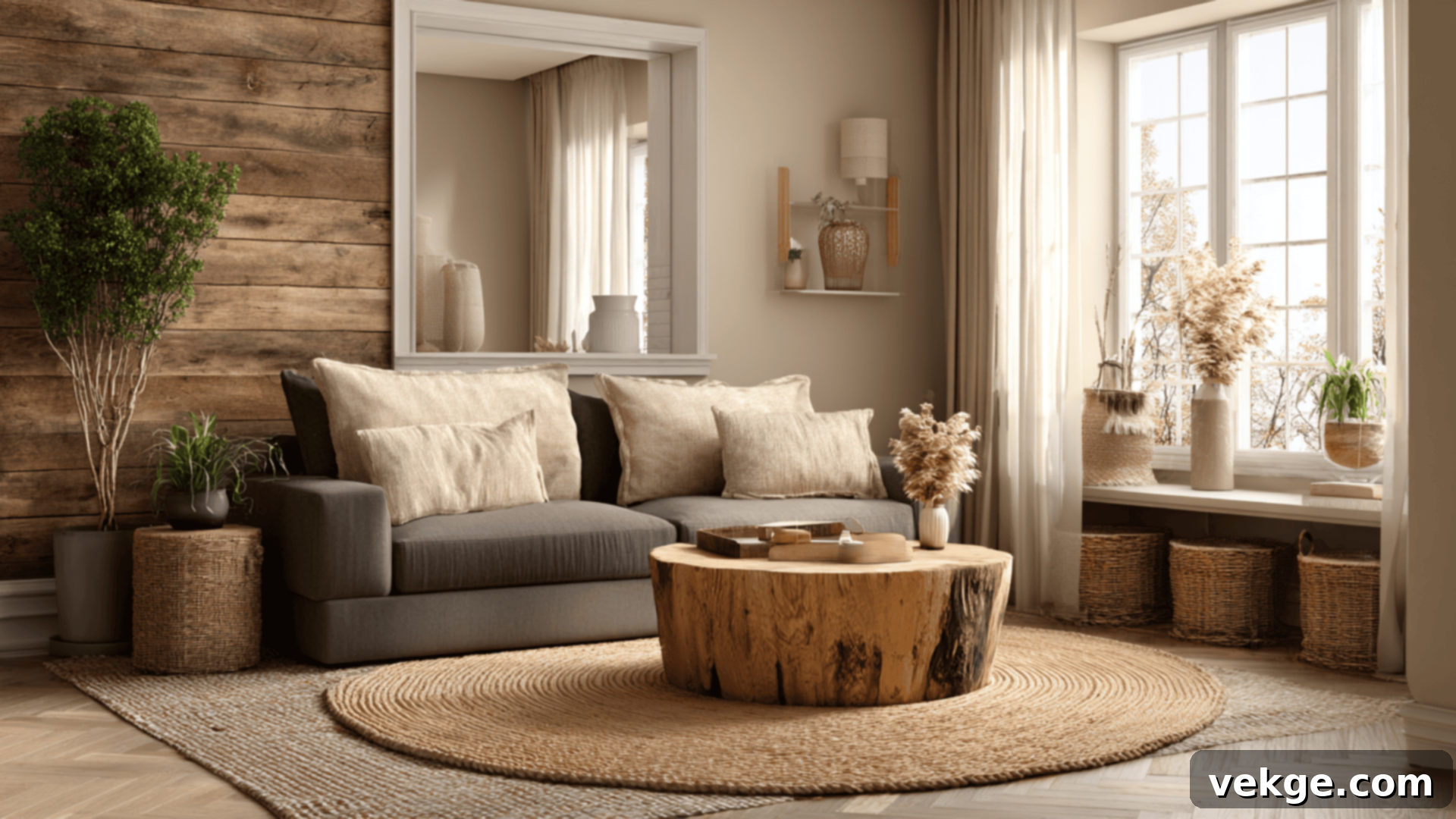The Ultimate Guide to Jute Rug Texture: Comparing Natural Fibers with Wool, Cotton, and Synthetics
Are you navigating the exciting yet sometimes overwhelming world of rug shopping, wondering about the unique texture of a jute rug and how it truly stacks up against other popular materials like plush wool, soft cotton, or resilient synthetics? Making the right choice for your home can feel like a big decision, especially with countless options vying for your attention.
Whether your priority is finding an eco-friendly option, something incredibly durable, or a budget-friendly statement piece, the texture of a rug plays a crucial role in both its aesthetic appeal and everyday comfort. This comprehensive guide will meticulously explore the tactile experience of jute rugs, offering a detailed comparison with wool, cotton, and synthetic alternatives. We’ll delve into everything from their inherent softness to their long-term durability, helping you understand the nuances of each material.
By the end of this deep dive, you’ll possess a crystal-clear understanding of which rug material best aligns with your space, lifestyle, and personal preferences. But before we pit jute against its counterparts, let’s lay the groundwork by exploring what precisely gives a jute rug its distinctive character.
Understanding Jute Rug Texture: From Plant to Your Floor
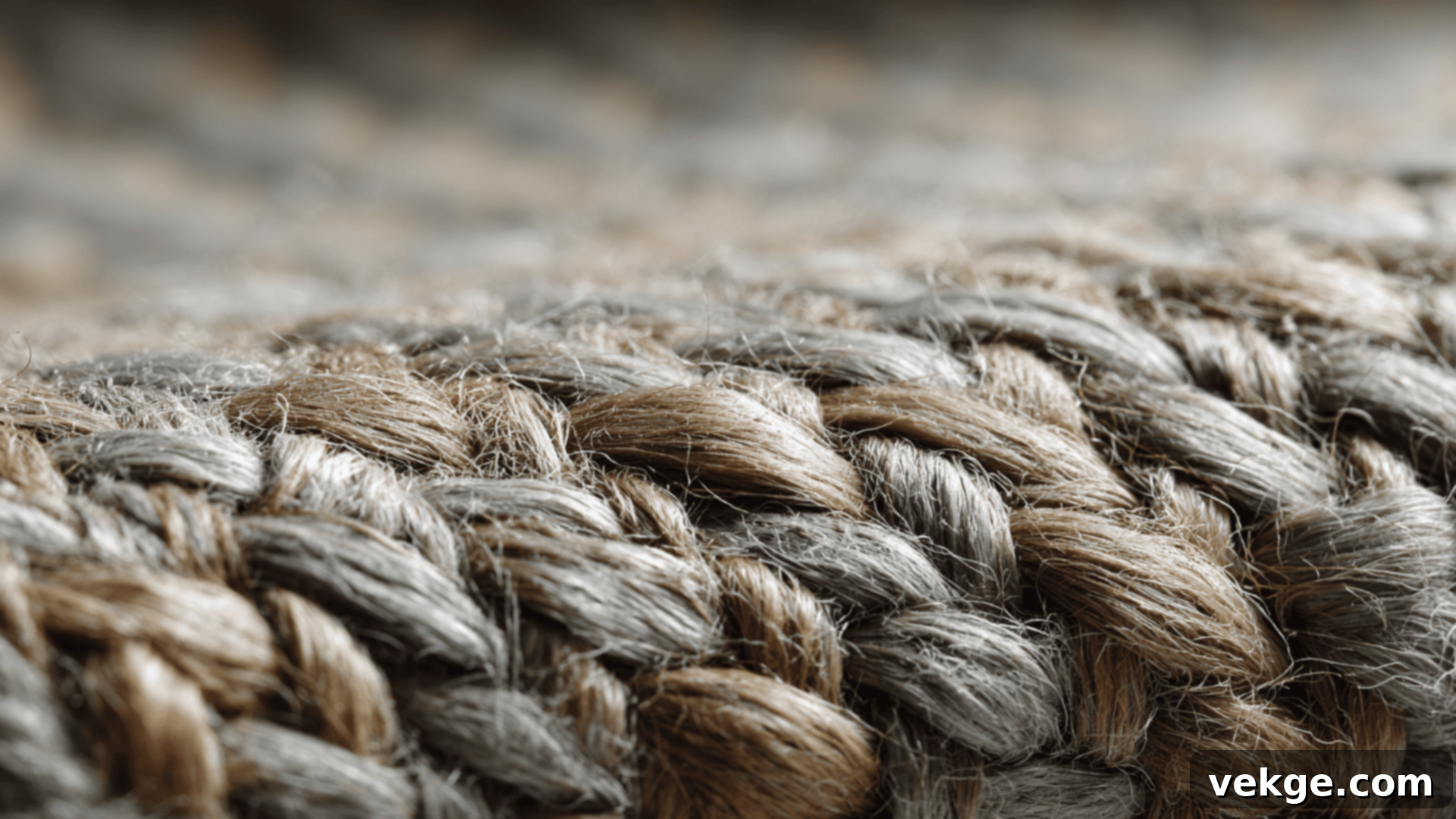
What is a Jute Rug Made Of? The Roots of Natural Beauty
Jute rugs are crafted from the remarkable fibers of the jute plant (Corchorus olitorius and Corchorus capsularis), a robust and rapidly renewable vegetable fiber. Primarily cultivated in the fertile deltas of India and Bangladesh, this plant is known for its long, shiny, and strong fibers. The cultivation of jute requires minimal pesticides and fertilizers, making it an exceptionally sustainable crop. These fibers are not only strong and inherently durable but also completely biodegradable, returning to the earth without leaving a lasting environmental footprint.
The journey from a plant stalk to a beautiful rug involves several key stages. First, the jute stalks are harvested, then ‘retted’ – a process where they are submerged in water to soften the fibers, allowing them to be easily separated. These raw fibers are then meticulously cleaned, dried, and spun into robust yarns. Finally, these yarns are skillfully woven, braided, or knotted by artisans to form the intricate patterns and structures of a jute rug. While pure jute rugs are incredibly popular, some varieties incorporate blends with other natural materials like wool or cotton. These thoughtful blends are often designed to enhance specific qualities such as softness, durability, or a more refined finish, offering a wider range of tactile experiences.
What Does a Jute Rug Feel Like? A Unique Underfoot Experience
When you first encounter a jute rug, its texture is one of its most defining characteristics. Jute rugs typically possess a distinctly coarse and rough texture, particularly those made from 100% pure jute. The natural fibers, while strong, can feel somewhat scratchy or even slightly prickly under bare feet. This tactile sensation might not appeal to everyone, especially those accustomed to the plush softness of synthetic or wool carpets.
However, this inherent roughness is not a drawback for many; instead, it’s celebrated as a core part of jute rugs’ unique, rustic, and organic appeal. It provides a grounding, earthy feel that connects a space to nature. For those who desire the natural aesthetic of jute but prefer a softer touch, the market offers excellent alternatives. Many jute rugs are now blended with materials such as chenille, cotton, or wool. These thoughtfully designed blends result in a rug that is considerably smoother and more comfortable to walk on, providing a gentle give underfoot while still retaining the distinctive, natural charm and visual texture of jute. This makes blended jute rugs a versatile choice, bridging the gap between natural aesthetics and enhanced comfort.
Variations in Jute Rug Texture: The Art of the Weave
The texture and overall feel of a jute rug are not monolithic; they can vary significantly based on the specific weave pattern and construction method employed. This craftsmanship allows for a diverse range of looks and feels, ensuring there’s a jute rug for almost any preference and functional need.
- Braided Jute Rugs: Often characterized by their thickness and density, braided jute rugs are created by plaiting strands of jute into robust cords, which are then coiled and sewn together. This construction results in a remarkably sturdy and durable feel, making them an excellent choice for high-traffic areas where resilience is paramount. Their substantial nature also provides a comforting, weighty presence in a room.
- Woven Jute Rugs: In contrast, traditional woven jute rugs, especially those with a tighter, more intricate weave, tend to have a lighter and smoother feel. This construction creates a more uniform surface, making them ideal for rooms where you desire a softer, more casual, and less bulky aesthetic.
- Flatweave Jute Rugs: A subcategory of woven rugs, flatweave jute rugs are particularly smooth and thin, offering a minimalist profile. They are reversible and lay flat, making them perfect for layering or for areas where door clearance is a concern. Their sleek texture is less pronounced underfoot compared to braided options.
- Chunky Knit or Boucle Jute Rugs: These contemporary styles feature larger, more open loops or knots, giving them a pronounced, almost sculptural texture. While still firm, the larger loops can provide a more forgiving feel than tightly woven rough jute, adding significant visual interest and a cozy, yet refined, appearance.
Understanding these variations is key. The way the jute fibers are woven or braided profoundly influences not only how soft or firm the rug feels underfoot but also how it visually contributes to and enhances the overall design of your space.
Pros and Cons of Jute Rugs: A Balanced Perspective
Jute rugs have surged in popularity as a go-to choice for homeowners looking to infuse their spaces with natural texture, earthy warmth, and an organic aesthetic. While they offer a wealth of benefits, it’s equally important to consider their potential drawbacks to ensure they are the right fit for your specific needs and lifestyle.
Advantages of Jute Rugs:
- Durability: Jute fibers are inherently strong and resilient. When woven into a rug, they create a robust surface capable of handling moderate to even high foot traffic, especially denser weaves. They stand up well to everyday wear and tear, making them a practical choice for busy households and frequently used rooms.
- Eco-friendly and Sustainable: As a natural plant fiber, jute is highly sustainable. It’s a rapidly renewable resource that grows quickly, requires minimal pesticides and fertilizers, and is completely biodegradable at the end of its life cycle. Choosing a jute rug contributes to a healthier planet by reducing reliance on synthetic materials.
- Affordability: Generally, jute rugs are significantly more affordable than other natural fiber rugs like wool, making them an accessible option for those seeking the beauty of natural materials without a premium price tag. This allows for greater flexibility in decorating on a budget.
- Natural Warmth and Aesthetic Appeal: Jute rugs excel at adding a cozy, inviting, and grounded feel to any room. Their natural, earthy tones (ranging from light beige to rich brown) and distinct texture bring an organic, relaxed, and effortlessly stylish vibe that complements a wide array of interior design styles, from bohemian and coastal to farmhouse and contemporary minimalist. They act as a neutral foundation, allowing other decor elements to shine.
- Sound Absorption: Their dense structure helps absorb sound, reducing echoes in larger rooms and contributing to a quieter, more tranquil home environment.
Disadvantages of Jute Rugs:
- Shedding: It’s common for jute rugs to shed, particularly when they are new. While this tends to decrease over time with regular vacuuming, it’s something to be aware of, especially if you or your family members have allergies or prefer a completely lint-free environment.
- Sensitivity to Moisture: Jute fibers are highly absorbent. This means they soak up water quickly, making them vulnerable to stains, water damage, mildew, and potential discoloration if exposed to excessive moisture. They are not ideal for damp environments like bathrooms, kitchens, or outdoor spaces. Prompt action is crucial for spills.
- Rough Texture: As discussed, the natural coarse texture can feel scratchy or uncomfortable under bare feet for some individuals, especially if the rug is 100% jute and placed in an area where people often sit or walk barefoot. A quality rug pad can help mitigate this by adding a layer of cushioning.
- Durability in Specific Conditions: While durable, they can show wear in extremely high-traffic pathways over many years, and they are not as resistant to heavy abrasion as some synthetic alternatives.
- Not Pet-Friendly for Accidents: Due to their absorbency, jute rugs can be challenging to clean thoroughly if pets have accidents, as odors and stains can penetrate deep into the fibers and be difficult to extract completely without causing further damage.
In conclusion, jute rugs offer an impressive balance of style, sustainability, and affordability, enriching any space with their natural charm. However, they may not be the optimal choice for every single setting or lifestyle. It is essential to carefully weigh these pros and cons against your specific needs, the intended location, and your aesthetic preferences to make an informed and satisfying purchase.
Jute Rugs in Different Spaces: Versatility and Style
The inherent versatility of jute rugs makes them a beloved choice for bringing natural texture and grounding warmth into virtually any room of your home. Their organic aesthetic allows them to integrate effortlessly into a multitude of interior design styles, enhancing the ambiance without overpowering existing decor.
Living Rooms: Anchoring Your Social Hub
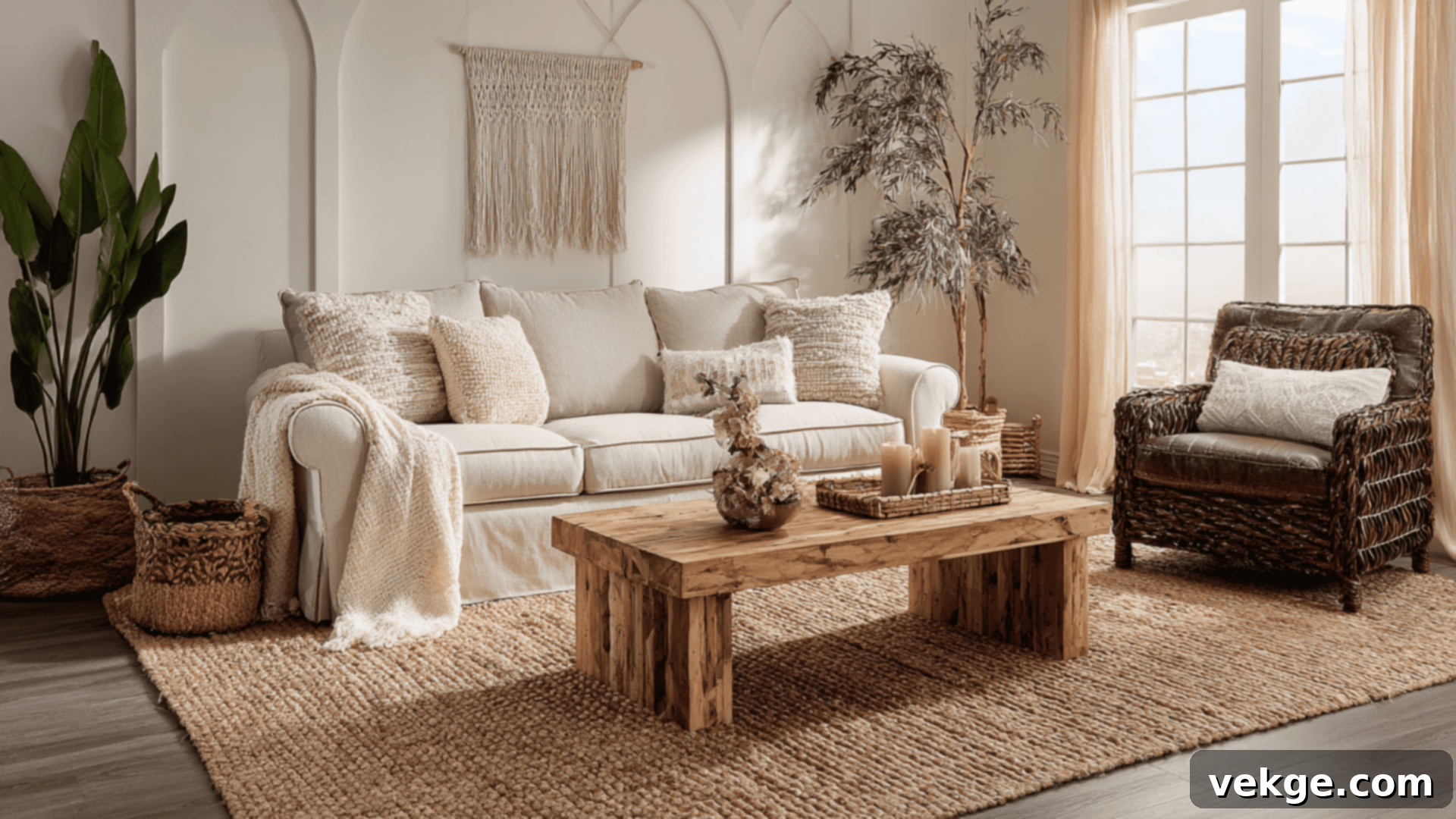
In the living room, a jute rug serves as an excellent foundation, adding a layer of inviting texture and a sense of grounding. Its natural tones act as a neutral backdrop that beautifully complements a wide range of decor schemes—from rustic farmhouse and cozy bohemian to minimalist modern and classic coastal. A large jute rug can effectively define the seating area, visually anchoring furniture and creating a cohesive, inviting zone for relaxation and socializing. Its presence introduces an organic element that softens sharp lines and adds a tactile dimension, making the space feel more connected to nature and inherently welcoming.
Bedrooms: Cultivating Calm and Comfort

For the sanctuary of a bedroom, jute rugs are an ideal choice for fostering a serene and calming atmosphere. Their natural texture, even if slightly coarse, contributes to a sense of unpretentious coziness and earthiness. Paired with soft, neutral-colored bedding, plush textiles, and warm lighting, a jute rug adds depth and warmth without introducing overwhelming patterns or colors. It helps absorb sound, contributing to a quieter sleeping environment, and provides a pleasant underfoot texture to greet your feet each morning. Consider a softer jute blend or layering a smaller, softer rug on top for ultimate comfort.
Entryways and Hallways: A Welcoming and Durable First Impression
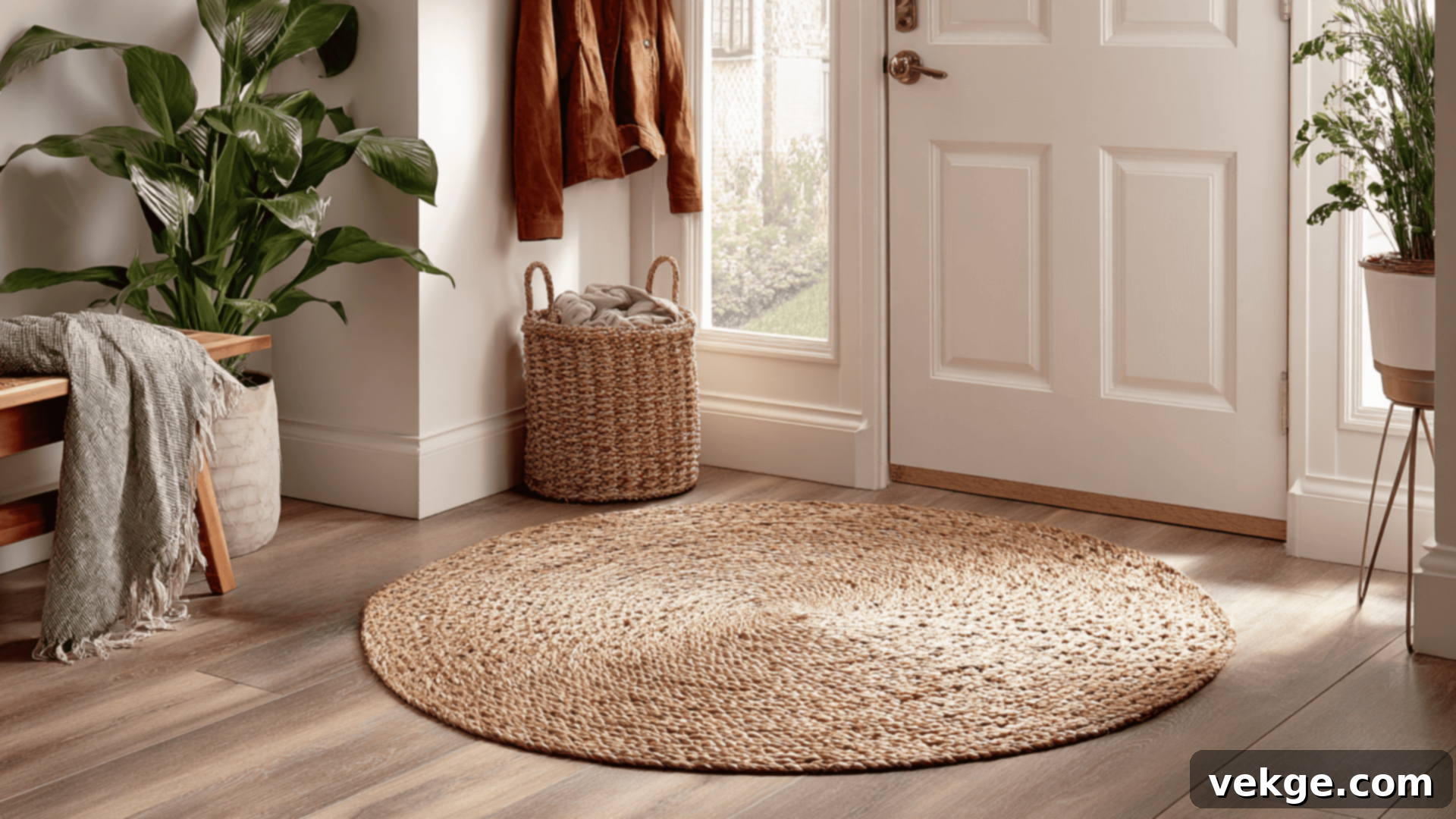
In high-traffic areas like entryways and hallways, jute rugs offer a perfect blend of style and practicality. They instantly welcome guests with a natural, earthy feel, setting a relaxed tone for the rest of your home. Their robust and durable fibers are well-equipped to handle the daily wear and tear of foot traffic, including dirt and debris from outdoors. The natural texture also helps to visually break up long corridors, adding interest and preventing the space from feeling too narrow or stark. While durable, remember their sensitivity to moisture; ensure they are not placed where they might frequently get wet from rain or tracked-in snow.
Cleaning and Maintaining Jute Rugs: Preserving Their Natural Beauty
Proper and consistent care is paramount to ensuring your jute rug retains its natural beauty, distinctive texture, and structural integrity for many years to come. While jute requires specific attention due to its natural fibers, the maintenance routine is straightforward. Here are some essential steps to keep your rug looking its best:
Essential Care Tips for Daily and Immediate Needs
- Regular Vacuuming: To prevent dirt and dust from settling deep into the fibers, vacuum your jute rug regularly – at least once a week, and more often in high-traffic areas. Always use a suction-only vacuum cleaner or set your vacuum to a high pile setting without the beater bar activated. The rotating bristles of a beater bar can snag, fray, and damage the delicate natural fibers, leading to excessive shedding and premature wear.
- Prompt Stain Removal (Blot, Don’t Rub): Jute’s absorbent nature makes immediate action crucial for spills. For any liquid spill, act quickly! Gently blot the area immediately with a clean, dry white cloth or paper towel. Never rub the stain, as this can push the liquid deeper into the fibers, spreading it and making it much harder to remove. For tougher or dried stains, a very small amount of mild soap (like a gentle dish soap mixed with water) can be applied to a clean cloth, then blotted onto the stain. Always test this solution on an inconspicuous area first. The key is to use as little moisture as possible and to dry the area thoroughly with a fan or hairdryer on a cool setting afterward.
- Avoid Excessive Moisture: This is perhaps the most critical rule for jute rugs. Jute fibers readily absorb moisture, which can lead to a host of problems including mildew growth, unpleasant odors, discoloration, and weakening of the fibers. Therefore, it’s vital to keep jute rugs dry. Avoid placing them in damp environments such as bathrooms, kitchens (especially near sinks), basements, or uncovered outdoor areas where they are exposed to rain or high humidity. If your rug does get wet, address it immediately by blotting and allowing it to air dry completely, using fans if necessary.
Long-Term Care for Lasting Durability
- Rotate Your Rug Occasionally: Like all rugs, jute rugs can experience uneven wear, especially in high-traffic pathways. To ensure uniform wear and prolong the rug’s life, rotate it 180 degrees every 3-6 months. This distributes foot traffic and sun exposure more evenly across the rug’s surface.
- Professional Cleaning: While spot cleaning is effective for minor issues, consider professional cleaning every few years, especially for larger rugs or stubborn stains. Always choose a professional rug cleaner who specializes in natural fibers and uses dry cleaning methods or minimal moisture techniques to prevent damage.
- Use a Quality Rug Pad: A good rug pad is invaluable for a jute rug. It not only prevents the rug from slipping and bunching, enhancing safety, but also provides an extra layer of cushioning, making the rug feel softer and more comfortable underfoot. Additionally, a rug pad creates a barrier between the rug and the floor, protecting both surfaces and allowing air circulation, which can help prevent moisture build-up and mold.
- Address Mildew and Odors: If your jute rug develops a musty smell or shows signs of mildew due to moisture exposure, move it to a dry, well-ventilated area immediately. For minor mildew, sprinkle baking soda over the affected area, let it sit for a few hours, then vacuum thoroughly. For severe cases, professional cleaning is recommended.
By following these care and maintenance guidelines, your jute rug will continue to offer its unique texture and natural charm to your home for many years, becoming a cherished and enduring part of your decor.
Jute Rugs vs. Other Materials: Making an Informed Choice
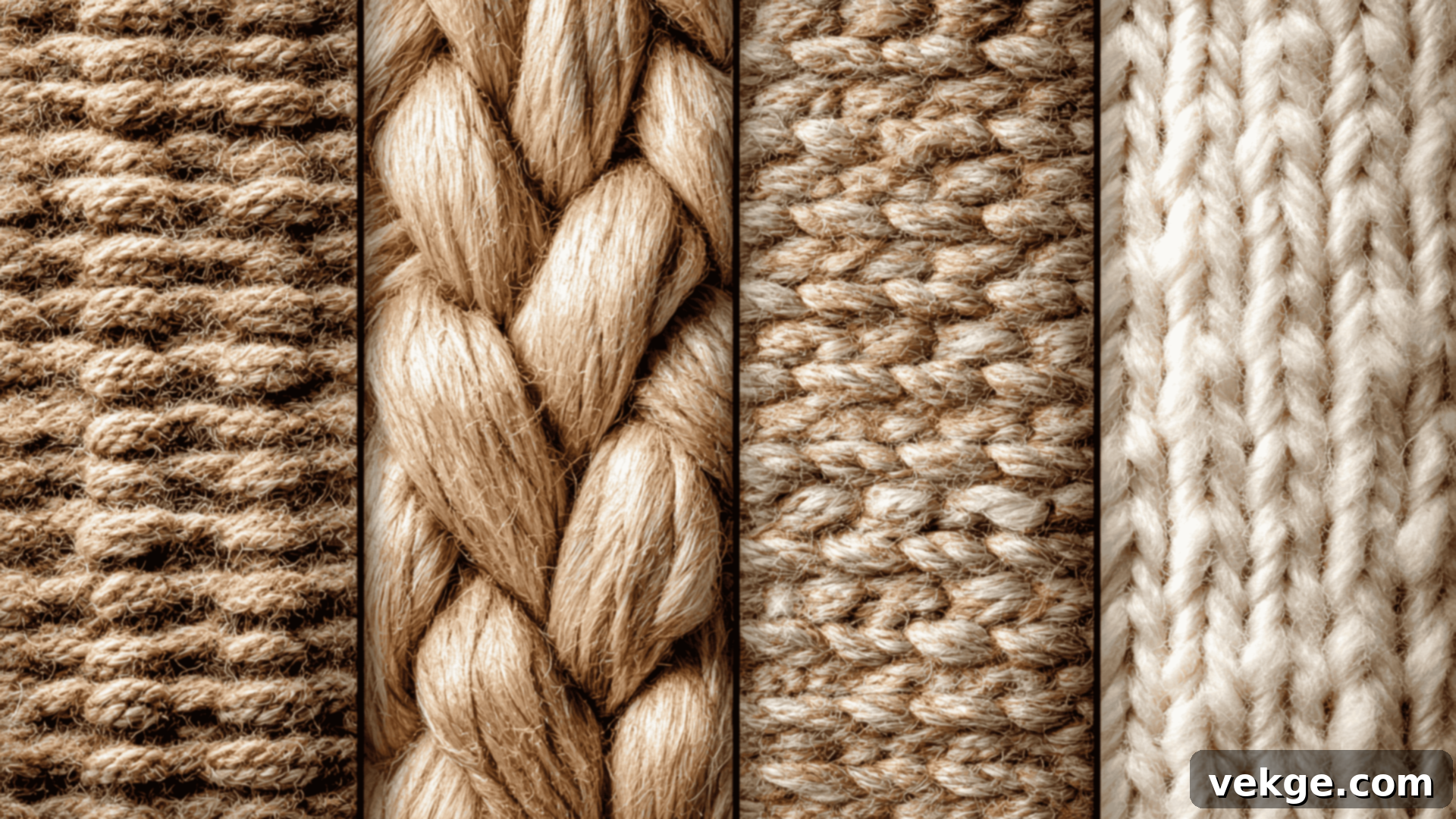
Selecting the perfect rug for your home involves weighing numerous factors, and understanding how jute differentiates itself from other popular materials like wool, cotton, and various synthetics is crucial. Each material brings its own set of strengths and weaknesses to the table, influencing everything from the rug’s tactile feel and long-term durability to its environmental impact and ideal placement within your home. Let’s delve into a detailed comparison to help you make the best decision tailored to your specific needs and preferences.
| Feature | Jute | Wool | Cotton | Synthetic (e.g., Polyester, Polypropylene) |
|---|---|---|---|---|
| Softness & Feel | Distinctly rough, coarse, and firm underfoot. Can feel scratchy, especially in 100% jute. Blends can be softer. | Incredibly soft, plush, and luxurious. Offers a bouncy, comfortable feel due to its natural crimp. Excellent for warmth and comfort. | Generally soft and smooth, with a casual, familiar feel. Can be flat or shaggy, but rarely as plush as wool. | Varies widely. Many are designed to mimic wool, offering a soft and often silky texture. Can feel artificial or very smooth depending on the type. |
| Aesthetic & Luxury | Offers a unique natural, rustic, and earthy look. Provides an organic, bohemian, or farmhouse aesthetic. Less formal, more casual luxury. | Embodies classic luxury and sophistication. Rich colors, excellent texture retention, and a timeless elegance make it highly desirable for premium spaces. | Known for its casual, relaxed, and approachable aesthetic. Often seen in flatweaves, dhurries, and braided styles. Less luxurious than wool. | Can mimic natural fibers, offering versatility. Ranges from basic utility to surprisingly sophisticated designs, though often perceived as less luxurious than natural alternatives. |
| Affordability | Generally one of the most affordable natural fiber rugs, offering great value for its size and style. Excellent for budget-conscious decorators. | Typically the most expensive rug material due to its premium quality, durability, and natural properties. Considered a significant investment. | Affordable to moderately priced, usually more expensive than jute but less than wool. Offers a good balance of cost and natural feel. | Usually the most affordable option, making it accessible for a wide range of budgets. Price can vary based on specific fiber type and construction. |
| Durability & Resilience | Durable for moderate to high traffic. Fibers are strong but can fray over time. Prone to moisture damage and susceptible to staining. | Highly durable and resilient. Naturally stain-resistant due to lanolin, resists crushing and matting. Excellent for high-traffic areas and lasts for decades with proper care. | Less durable than wool or synthetics. Tends to wear out faster, especially in high-traffic areas, and is more prone to staining and fading. | Very durable and highly resistant to wear, stains, fading, and moisture. Ideal for high-traffic and spill-prone areas. Excellent for longevity. |
| Eco-friendliness | Highly sustainable and biodegradable. A rapidly renewable plant fiber with minimal environmental impact during cultivation. An excellent eco-conscious choice. | A natural, renewable resource, but the environmental impact of sheep farming and processing can be higher than jute. Not as easily biodegradable as jute. | Natural fiber, but conventional cotton farming can be water-intensive and use pesticides. Organic cotton is more eco-friendly. Not easily biodegradable in landfills. | Generally not sustainable as it’s made from petrochemicals (plastics). Not biodegradable and contributes to plastic waste. Less eco-friendly option. |
| Care & Maintenance | Requires dry cleaning methods or minimal moisture. Prone to mildew and damage if wet. Regular vacuuming (suction only). | Relatively easy to clean due to natural stain resistance. Can be spot cleaned; professional cleaning is recommended periodically. Resists dirt well. | Easy to clean, often machine washable for smaller rugs. Can be prone to shrinking or fading if not cared for properly. | Very easy to clean, highly resistant to most stains, and can often be washed or deep cleaned without damage. Ideal for households with kids/pets. |
Best Use Cases for Each Material
- Jute Rugs: Ideal for low to moderate traffic areas such as living rooms, bedrooms, entryways, and home offices where the focus is on creating a natural, rustic, and grounding aesthetic. They are perfect for those seeking an eco-friendly and affordable option to introduce texture and warmth. Best avoided in consistently damp environments.
- Wool Rugs: The prime choice for colder climates or any space requiring exceptional warmth, luxury, and superior comfort underfoot, such as formal living rooms, master bedrooms, and dining rooms. Wool’s durability and natural resilience make it a long-term investment for high-traffic and cherished areas.
- Cotton Rugs: Excellently suited for casual spaces or rooms where easy and frequent cleaning is a priority, such as kitchens, dining rooms, kids’ playrooms, or bathrooms (if easily washable). Their softness and light feel make them a comfortable, low-maintenance option for laid-back interiors.
- Synthetic Rugs (e.g., Polypropylene, Polyester): The ultimate choice for high-traffic areas, busy households with children or pets, or any location prone to spills and moisture, including kitchens, bathrooms, basements, and outdoor patios. Their durability, stain resistance, and affordability make them a highly practical and versatile option.
Where to Buy Jute Rugs: Trusted Retailers and Smart Shopping
Once you’ve decided that a jute rug is the perfect addition to your home, the next step is finding the right one. Fortunately, many reputable retailers offer a diverse selection of jute rugs, catering to various budgets, styles, and quality preferences. Knowing where to look and what to consider can significantly streamline your shopping experience.
Top Retailers for Jute Rugs
These retailers are highly regarded for their selection, quality, and customer service when it comes to jute rugs:
- Pottery Barn: A go-to for high-quality, beautifully crafted jute rugs that often blend traditional artistry with modern designs. They offer a range of sizes and unique weave patterns, making them an excellent choice for anchor pieces in living rooms and bedrooms. Their rugs tend to be on the higher end in terms of price but offer superior construction and aesthetic appeal.
- Ruggable: Innovatively offers washable jute-blend rugs, combining the natural look of jute with the practicality of easy cleaning. Their unique two-piece system (a rug cover and a rug pad) allows you to machine wash the cover, making them ideal for homes with pets, kids, or anyone seeking hassle-free maintenance without sacrificing style.
- World Market: A fantastic destination for affordable yet stylish jute rugs, World Market specializes in globally inspired designs that often feature unique textures, fringes, and rustic flair. They are a great option for adding character and warmth to your space on a budget.
- Wayfair: As an online retail giant, Wayfair boasts an incredibly wide selection of jute rugs at virtually every price point. You’ll find everything from basic flatweaves to intricate braided designs, making it easy to filter by size, style, and budget to find the perfect fit for any room.
- Lulu & Georgia: For those seeking a more premium and design-forward option, Lulu & Georgia offers exquisitely designed, high-quality jute rugs with a sophisticated and curated feel. Their collection often features unique patterns, elevated textures, and thoughtful blends, ideal for creating a refined, natural aesthetic.
- West Elm: Known for its modern, clean aesthetic, West Elm offers contemporary jute rug designs that often incorporate interesting patterns or natural variations. Their collection frequently includes jute blends for added softness and unique visual appeal, perfect for modern and transitional interiors.
Smart Online Shopping Tips for Jute Rugs
Shopping for rugs online offers unparalleled convenience and selection, but a few strategic tips can help ensure a successful purchase:
- Thoroughly Review Shipping and Return Policies: Before committing to a purchase, always check the retailer’s shipping options, estimated delivery times, and, most critically, their return policies. Rugs can be bulky, and return shipping costs can be substantial. Look for retailers that offer free shipping and returns, or at least a clear and fair return process. Understand the timeframe for returns and any associated fees.
- Look for Warranties: While not all rugs come with extensive warranties, some higher-quality jute rugs might. A warranty can provide peace of mind, protecting your investment against manufacturing defects or premature wear under normal conditions.
- Read Customer Reviews and View Photos: Customer reviews are invaluable. They offer real-world insights into the rug’s actual color, texture, shedding, durability, and overall quality. Pay attention to comments about how the rug feels underfoot and how well it holds up over time. Many reviews also include customer-uploaded photos, which can give you a more accurate visual than professional product shots.
- Accurately Measure Your Space: This cannot be stressed enough. Always measure your room and the intended placement area meticulously before buying. Consider furniture placement and foot traffic paths to determine the ideal rug size. Use painter’s tape on the floor to visualize the rug’s dimensions in your space.
- Order Samples (if available): If you’re unsure about the color or texture, see if the retailer offers small samples. This allows you to experience the rug’s true look and feel in your home’s lighting before investing in a full-sized piece.
- Check for Rug Pad Recommendations: Many jute rugs benefit significantly from a rug pad. Check if the retailer recommends a specific type of pad, as this can enhance comfort, prevent slipping, and extend the life of your rug.
Conclusion: Embrace the Natural Charm of Jute
Choosing the right rug material is a pivotal decision that significantly impacts the comfort, style, and functionality of your home. As we’ve explored, understanding the distinct texture of a jute rug and how it compares to the softness of wool, the familiarity of cotton, and the resilience of synthetics empowers you to make a truly informed choice.
If you’re drawn to eco-friendly options, appreciate natural aesthetics, value affordability, or seek a durable yet organic floor covering, the unique character of jute is undoubtedly compelling. Its earthy tones and coarse texture bring an authentic, grounding presence to any room, fostering a relaxed and inviting atmosphere. While its rough feel and sensitivity to moisture require thoughtful consideration, the numerous benefits often outweigh these minor considerations, especially when paired with proper care and placement.
Take a moment to reflect on the specific needs of your space, your lifestyle, and your personal design preferences. Does the rustic charm and natural appeal of jute resonate with your vision? Remember that whether you opt for pure jute or a softer blend, proper care and maintenance will ensure your chosen rug remains a beautiful and enduring element of your home decor for years to come. By making a conscious decision, you’ll select a rug that not only looks stunning but also perfectly complements the rhythm of your daily life.
For more home decor inspiration, in-depth material guides, or practical tips on enhancing your living spaces, be sure to explore my other blogs. Happy decorating!
